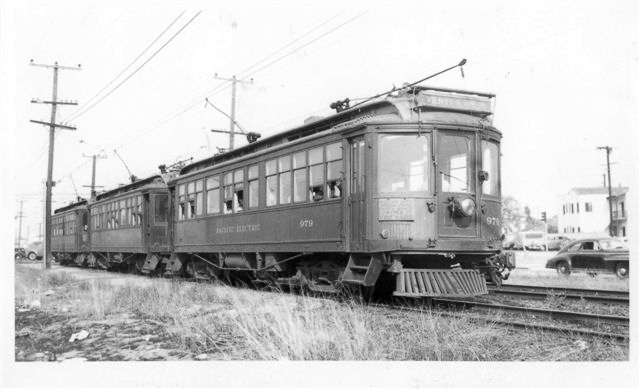Pacific Electric No. 979: Public Transit with Class and Dignity
By Ralph Cantos
In this modern day and age of “low floor,” hermetically sealed, air-conditioned transit conveniences, who can dispute the classic, almost Victorian beauty of Pacific Electric’s 950-class interurbans.
The cars were built in 1907 for the Los Angeles Pacific’s proposed “Vineyard Subway” by the St. Louis Car Co. They were delivered to LAP in dark green color and numbered 700-749.
When the cars came into the PE portfolio of rail cars, their already good looks were improved by the addition of a second, air-operated trolley pole, and a large, roof-mounted destination roller sign. The cars were renumbered into the 950-999 range in 1925 with the arrival of the third order of Brill-built Hollywood cars.
In time, their open section was enclosed with brass sash windows. Although not particularly fast, the 950s could roll along at a respectable 48 mph if given the chance.
With the exception of car no. 999, the 950s stood out from the other PE wood interurbans in having a 3-window front end rather the PE’s traditional 5 windows. The 950s would render the PE dependable, if not spectacular service (when compared to the San Berdoo 12s) for more than 30 years.
But by 1937 with the Stare Railroad Commission and the City of Los Angeles demanding the retirement of ALL of PE’s wood-bodied interurbans before 1940, it looked like the end of the line for these handsome cars. Gone already were the mighty 800s, fastest of all PE interurbans. Scrapping of the 950s began when the last of the 800s were burned at Torrance Shops’ “back 40”. Nineteen of these wonderful cars had already met their demise by fire, when World War II broke out and EVERY transit vehicle, across the USA, no matter how old, be it rubber tired or steel wheeled, was saved from the scrap pile and returned to service.
PE put an immediate halt on the scrapping of the remaining 31 950s. The tattered and neglected cars were put through the Torrance Shops and emerged in 1942 in “better than new” condition. And so the 950s would roll on, mile after mile, all during the war, carrying capacity passenger loads. At war’s end, the 950s — now almost 40 years old — would continue on, day after day, month after month, year after year.
But by 1950, time had finally caught up with the Venice Short Line and the line’s mainstay, the 950s. The September 17, 1950, abandonment of the VSL brought an end to the career of the beautiful cars.
Noted rail fan Ira L. Swett made an attempt to purchase car no. 994, but with the Southern California trolley preservation movement several years into the future (no Travel Town, no OERM) and a lack of funds, Ira Swett gave up the effort and the 994 was lost. One car, no. 993, was set aside and used as a locker room for employees of National Metals & Steel Co. of Terminal Island, where the cars were being scrapped.
There the 993 would sit, minus its trucks, until replaced by all-steel Hollywood car no. 5094 around 1957.
In a moment of fate, railfan Richard Fellows, whose boat-building business bordered National Metals, purchased the body of the 993 in hopes of someday mounting it on rubber tires in the same way he did in the creation of no. 1058 (built from the body of retired 963). Richard also purchased the body of car 5094, when it was replaced by the body of a mint-condition LATL H-3 in 1960.
When Richard Fellows passed away, the 1058 was eventually purchased by the City of LA for use on the San Pedro Waterfront Red Car line, where it was restored as an operating rail car by the City with technical assistance from OERM members. The bodies of 993 and 524, which Richard had begun to rebuild, were purchased by the Museum and now sit on almost-correct trucks from the Chicago El lines, with both cars awaiting restoration. The 5094/655 was a gift to OERM by Mrs. Fellows for assistance by OERM members with the estate sale. It came to OERM still mounted on its rubbers tires, but now sits on motorless Hollywood car shop trucks. The body is immaculately restored, but it will need a lot of work to reinstall electrical and pneumatic gear to be operational again.
This beautiful photo taken in 1947 shows car 979 heading up an afternoon rush hour train at Hauser Blvd. This photo show well, the undeniable beautiful lines of the 950s. Given the opportunity, what LAMTA commuter in 2015 would pass up the chance ride aboard a breezy 950 instead of a modern day, air conditioned low floor bus with its jarring rough ride.
Ralph Cantos Collection



The body (without trucks) of car 993 is now at Orange Empire Railway Museum. I donated a bunch of parts from car 963 (714) to help in restoring 993. I never had the chance to ride on these beautiful 950 (700) class cars, but hope it will be possible one day.
Let them know you support the restoration of 993, (the only existing car of this class?), and donate for that purpose.
I see photos of some of “modern trams” in Europe and they look like they were designed by a vacuum-cleaner company. There’s one model that reminds me of a caterpillar. But I don’t think the classic designs are likely to make a comeback.
Sounds like the short line running in San Pedro may be lost because of lack of planning to incorporate into the re-development of Port of Call Village. The fact that it has been running at a huge loss might have something to do with it too.
Sounds like 1955 all over again. A rail line operating at a huge loss, and the talk has it that they may replace it with rubber tired “trolleys”.
Many years ago, one of my buddies owned a Volkswagen, back in the days when “Beetles” might sport stickers reading “Made in der Black Forest by Elves”. He had an assortment of fake German terms for various parts of the VW. One day we were out and about and saw one of those phony “trolley car” bodied buses. It was quickly dubbed “Ein Ersatz Strassenwagen”.